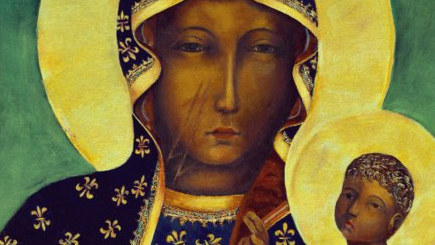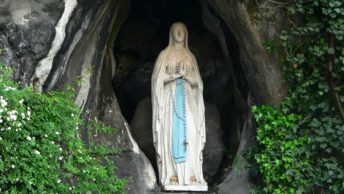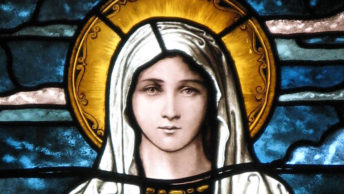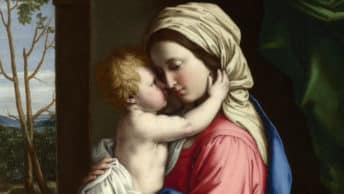I have been graced by God to be born on August 26, 1972. As you know, August 26 is the Solemn Feast Day of Our Lady of Czestochowa, the Queen and Protectress of Poland. My beloved parents got married on August 25, 1957. History has it that August 25 is the birthday of St Maria Faustina Kowalska, the Secretary of Divine Mercy. In all truth, can I be more spiritually Polish than this? No wonder why I have a deep connection and love for this holy land of God’s Mercy and the love and protection of Mary, the Mother of God and Our Heavenly Mother!
Today I say that Our Lady Of Czestochowa is not only a huge inspiration for Polish people but also for those who are, in some way, as I am, spiritually connected to this special country. Our Lady of Czestochowa, in Polish and world history, has always been the solid rock to keep people faithful to Jesus no matter the blowing winds of evil.
The special image of the Virgin Mary shows a mother who, although she was scarred she kept being faithful and persevering in the accomplishment of her duties. This most faithful mother never, even for a single moment, rejected her children. On the contrary, she kept gazing loving at them with her usual uncomparable compassion.
But what can we know about Poland’s Black Madonna? Any Polish person you might encounter on the streets in Poland would certainly tell you with joy and pride that Our Lady of Czestochowa is the Queen of the Polish Nation and their Beloved Mother and Lady of Miracles. On the other hand s/he would immediately arrive at the conclusion that Jasna Góra Shrine is Poland’s spiritual capital. But there is much more than this.
For instance, the image of Our Lady of Czestochowa has a number of dress-like converings. This makes perfect sense since in this image we are honouring the Blessed … among women (Luke 1:42). In the treasury of Jasna Góra one finds some 11 gowns of the highest quality. What strikes the pilgrim is the fact that each gown has its own particular story to tell. Every gown is put on the image of Mother of God in a specified event. Thus, one comes across the Dress of Entrustment, fashioned from 9 kilograms of amber and inlaid with thousands of diamonds. Another one is the Commander’s Gown, which history tells us that it is a votive offering of the Polish generals of the Second Republic. This was made up of a number of distinctions as well as orders. We also find the Millennium Dress, made with blue embroidery, displaying the notion of lilies.
A striking feature concerning Jasna Góra is the fact that although this holy place does not give idea of being a hermitage, however, the Pauline monks who inhabit the monastery stand as a religious order which hails from the eremite movement. St Pope John Paul II joke about it, particularly at the conclusion of the Sixth World Youth Day, while talking to the youths: Do you know what the fathers and brothers in the white habits who occupy the Jasna Góra Shrine are called? They are called the Paulines, sons of St Paul the first hermit. They are the sons of St Paul the hermit and they are hermits themselves – a true hermitage we have made them!
One can rightly qualify Jasna Góra as being at Mother’s home! When it was officially announced that the Sixth World Youth Day would take place in Czestochowa in the month of August 1991, immediately a debate was stirred regarding the place which was chosen to host the event. At first the area indicated for the celebration of this World Youth Day was the meadow on the western side of the shrine or a former military airfield in Rudniki. However, St Pope John Paul II opted for another alternative, namely the square just in front of the shrine. This particular area is special due to the countless historical events, especially actos of entrustment To Our Lady. The Holy Pontiff coined so well when he said: It will be tight, but cozy … as Mother’s home! Thanks to his initiative, heaps of young people coming from every corner of the globe would have the opportunity to be close to Mother’s heart. The turnout of the event was so big that young certain people did exactly as Zaccheus did, climbing on the trees of the vicinity.
The custom of giving gifts in exchange for graces received knows its origins in the 15th century. As is customary in many other Marian sanctuaries around the world, even in Czestochowa we find gifts hung on the chapel walls that contain the miraculous image of the Madonna. Furthermore, they are put in the Jasna Góra treasury that, by itself, presents a very interesting Polish history lesson.
In the treasury one also encounters other liturgical vestments and ornaments such a monstrance offered by King Sigismound the Elder of Poland, precious pieces of art, jewelry coming from different epochs, including a rosary of Queen Bona. One also encounters daily features such as a gold cup and clock given by King John III Sobrieski, pen of the writer Henryk Sienkiewicz as well as the medal of the Noble Prize given to Lech Walęsa. We should also keep in mind that certain gifts are treasured simply because of the historical context in which they played a significant role. Thus, concentration camp survivors did bring their rosaries to Our Lady. These rosary beads which were made of bread and a crown of thorns made of barbed wire. Of important significance are certainly the votive offerings given by the Pope themselves such a monstrace from St Pope John XXIII, a chalice given by St Pope Paul VI, a gold rose from St Pope John Paul together with a blood-stained stole worn by this Polish Pontiff when there was the assissination attempt on May 13, 1981.
Besides the fact that countless pilgrimages came practically from around the world to visit Jasna Góra, the image of Our Lady of Czestochowa has been travelling around Poland. On August 26, 1957, there was the moment of the so-called “sacred kiss”. By the latter we mean when the copy which was intended to be taken to parishes to people who, for some reason, could not travel to Jasna Gora, was finally touched ot the original miraculous image.
For 23 years the copy visited all Polish parishes even though certain parishes were simply reached only by the frame of the painting. The travelling icon did arouse suspicion among the communist regime so much that on September 4, 1966, it was officially “arrested” by the communist regime. It was kept in prison till 1972. However, in May 1985, we notice another visitation phase which occurred and kept going on till today.
Another intriguing fact around the Black Madonna is that the icon of Our Lady of Czestochowa is one of a number of other Black Madonnas. For instance, we find the La Moreneta or the little dark-skinned one, Our Lady of Monsterrat in Catalonia. According to some because there is a resemblance between the two images the Catalans were called by other Spaniards los polacos, meaning the Poles. The other well-known Black Madonnas are, of course Our Lady of Einsiedeln, in Switzerland, and Our Lady of Guadalupe, whom the Mexicans call her La Morenita.
Our Lady of Czestochowa is globally known for the miracles attributed to Mary’s intercession. Countless are the physical and spiritual healings which occurred. Cure from illnesses, or becoming a parent and even being resurrected from the dead form part of a long list of miracles thanks to the prayer of Our Lady of Jasna Góra. The Pauline monks wisely kept note of these miracle happenings from the year 1402. One of the most phenomenal miracles which happened dates back to the early 16th century when a mother together with her two children came back to life when they were put in front of the image of Our Lady of Czestochowa. A painting of this event can be found in the section of the sanctuary where it connects the Basilica with the Chapel of the Miraculous Image. It also needs to be remembered that the rich archive provides us with some 30 testimonies of people being resurrected thanks to the intercession of the Lady of Czestochowa. These happenings occurred some centuries ago. Could it be that these people had a stronger faith than ours?
Whatever the case is one thing stands sure: Our Lady of Czestochowa, as a strong woman of faith, exhorts you and I to maintain the faith, irrespective of what might happen to us during our day. Let us start our day by consecrating it to the Black Madonna, who has come to the aid of countless number of people in their most difficult and challenging trials they had to face.
Holy Mother of Czestochowa, Thou art full of grace, goodness and mercy. I consecrate to Thee all my thoughts, words and actions, my soul and body. I beseech Thy blessings and especially prayers for my salvation. Today, I consecrate myself to Thee, Good Mother, totally with body and soul amid joy and sufferings to obtain for myself and others Thy blessings on this earth and eternal life in Heaven. Amen.








